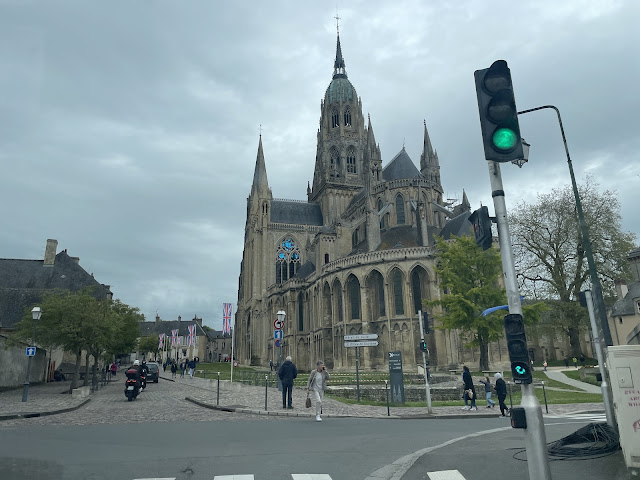Having completed the D-Day beaches, our next day was going to be spent visiting the two historic towns in Normandy, Caen and Bayeux.
The weather had taken a turn for the worse, instead of the sunny 18 degrees of the Tuesday we now had rain and about 12 degrees.
Our first stop on the drive was Saint-Mere-Eglise. The town has a claim of being the first French town liberated on D-Day (however some sources claim that a smaller town further east was liberated slightly earlier). The town was important as it lay on a crossroad that could be used to attack Omaha and Utah Beaches.
On D-Day the town was first attacked by paratroopers, who were accidentally dropped directly over the city and suffered many casualties. One famous story is of John Steele from 505th Parachute Infantry Regiment, who caught his parachute on the spire of the town church. Having not been able to free himself and wounded by flak, he pretended to be dead for two hours until he was captured by the Germans. A sculpture of John and his parachute adorns the church in memorial.
Our next stop was Arromanches again to take some additional photos (which I included in the Beaches photo set).
Next we headed to Bayeux. The settlement of the area dated from the 1st century BC with the name Augustodurum and was mostly destroyed by Vikings in the 800s. It is famous for the Bayeux Cathedral and the Bayeux Tapestry.
The cathedral - Cathedral of Our Lady of Bayeux (Cathédrale Notre-Dame de Bayeux) was consecrated in 1077 under the rule of William, Duke of Normandy, otherwise known as William the Conqueror. It is believed that it was in this chapel that Harold Godwinson took an oath to support William's claim to the English throne.
To fully understand the invasion of England by William, it is important to understand some of the history of the times.
At the end of the 10th century, England was ruled by Æthelred the Unready, who several children from his first wife, Ælfgifu, and three with his second wife, Emma of Normandy - son Edward, a daughter Goda and another son Alfred.
When the Vikings raided England, Sweyn Forkbeard seized the throne and Emma with Æthelred and her children to Normandy. After Sweyn died in 1014, Æthelred was returned to England as king. After Æthelred's death, Cnut, son of Sweyn became King. Emma married Cnut and her other children fled again to Normandy. Emma and Cnut had a child, Harthacnut.
When Cnut died, the Danes were not able to hold their claim to the throne, so the throne fell to Cnut's half brother, Harold, while Harthnacnut became King of Denmark. Edward and Alfred returned to England and were captured, with Alfred being killed by Harold. When Harold died, Harthacnut took the throne and made Edward his heir.
Edward became king in 1043 and had no children. When he died, the succession was unclear.
Earlier, in 1064, Harold Godwinson, a powerful Earl at the time had been shipwrecked and captured by the Count of Ponthieu. Some stories claimed that he had been sent to appoint William of Normandy as the King's heir, others that he was seeking to free his family members who had been held hostage. William of Normandy secured Harold's release. It is then believed that Harold swore an oath to William in the Bayeux Cathedral that he would support William's claim to the throne.
When King Edward fell into a coma, it is claimed that he proclaimed Harold as his heir. Upon his death in 1066, Harold was proclaimed King of England. William, claiming that Harold had broken his oath, invaded England and Harold was killed, leaving William as the King of England.
It was believed that Harold died from an arrow to the eye - based on a segment of the Bayeux Tapestry, but this is still debated.
The text here reads "Here King Harold is killed", however scholars are unsure if this was a later addition and whether the person being crushed under the horse is actually Harold.
 |
| Fossil found while excavating the cathedral |
Our next stop was the Bayeux Tapestry museum. The Bayeux Tapestry was made in the 1070s and is 70m long. It tells the story from King Edward sending Harold to Normandy, Harold's shipwreck and capture, his rescue by William, a campaign with William and Harold against Conan II, Duke of Brittany, the rumoured oath to support William's claim, the death of Edward and the Battle of Hastings where Harold is killed.
We couldn't take photos in the museum, but here are some pictures from online of some interesting parts:
 |
| Harold with the arrow in his eye? |
 |
| A vomiting donkey? |
 |
| Halley's Comet |
 |
| Battle of Hastings |
 |
| Wading to the boats and keeping the dogs dry |
 |
| Harold saving soldiers from the quicksand outside Mt Saint Michal |
The full tapestry with details can be seen here.
Our next stop was Caen. By this time we were getting tired and the rain had really set in, so we didn't spend as much time as we planned - instead driving by and taking some photos.
and Caen Castle, former stronghold of William the Conqueror:
Just outside Caen was our final stop, the Pegasus Bridge.
The Pegasus Bridge was formally known as the Bénouville Bridge, and was a bridge crossing the Caen Canal. It was a major objective of the D-Day landing for the 2nd Airborne Battalion, a glider group. They captured the bridge and held it against German counter attacks, preventing the German troops from counter-attacking the allied beaches. The bridge was later replaced, with the original being moved to a museum. It was renamed the Pegasus bridge after the insignia for the 1st Airborne Corps.
After the bridge it was a long drive back to the apartment for dinner and sleep.



























No comments:
Post a Comment